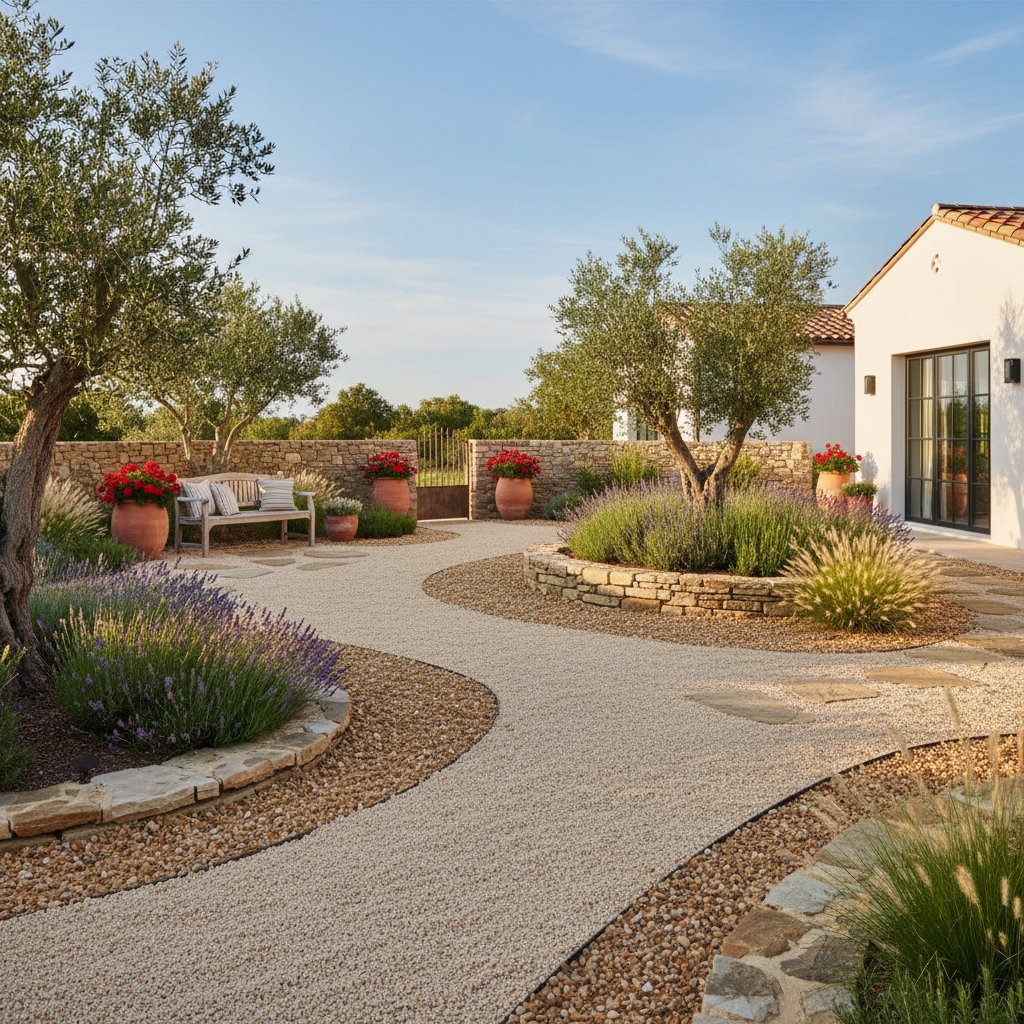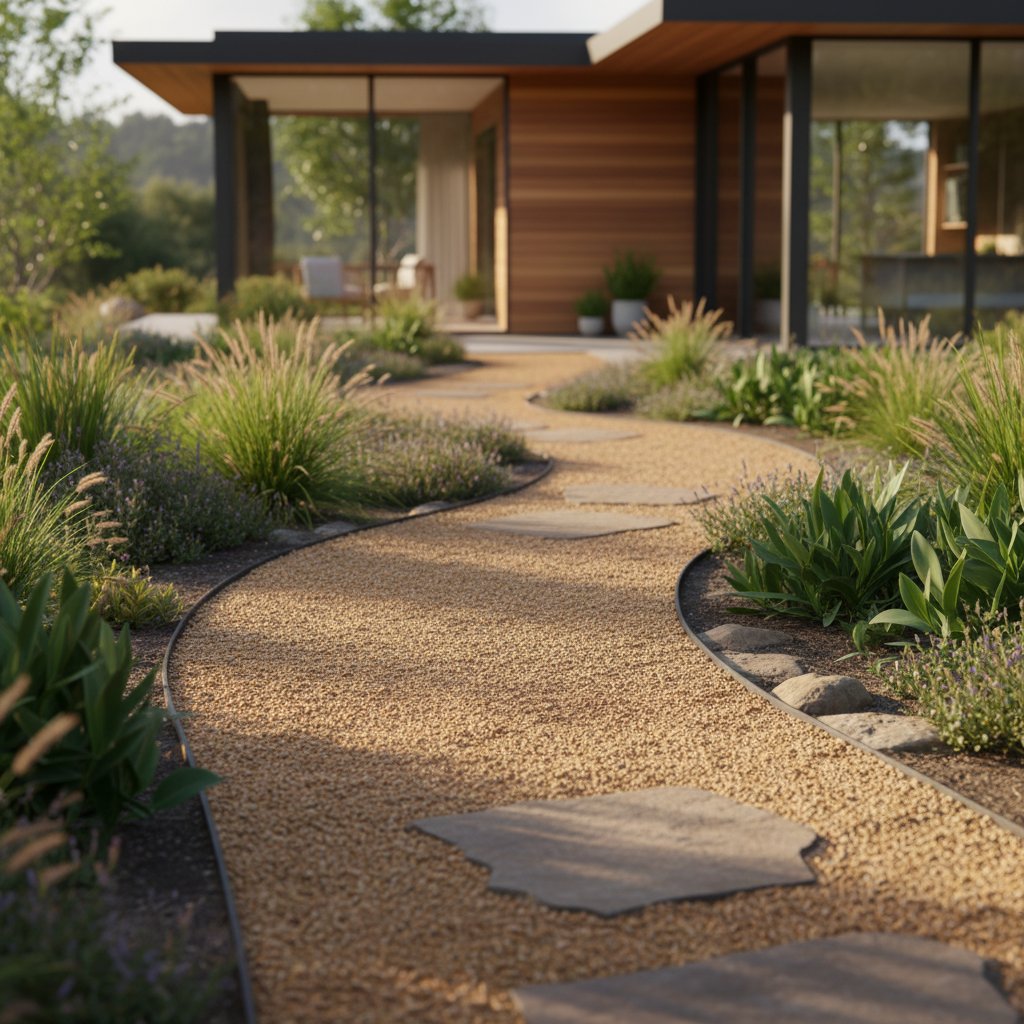2025 Budget Strategy: Embrace Mediterranean Gravel Gardens
Homeowners often face the burden of constant yard care, including watering, mowing, and weeding. Lawns that once appeared vibrant may now show patches of wear and require ongoing attention. Numerous individuals seek outdoor areas that provide tranquility, require little maintenance, and remain cost-effective. A rising trend, the Mediterranean-inspired gravel garden, aligns precisely with these needs.
This design incorporates texture, warmth, and restraint to produce enduring landscapes that flourish with limited intervention. With careful planning, implementation occurs affordably.
Discover Beauty in Restraint
Gravel gardens emphasize simplicity over excess. They substitute perpetual maintenance for inherent elegance and composed harmony. Rather than pursuing an ideal lawn, individuals craft environments that appear stable and undemanding. Gravel serves as the base for vegetation adapted to sunlight and arid conditions.
Visualize sun-warmed stones beneath your feet, resilient herbs at ankle height, and the subtle aroma of lavender in the breeze. Appeal derives from equilibrium rather than profusion. Each element, from plants to stones and containers, enjoys ample room. The garden conveys abundance while requiring scant reciprocation.
For yards that seem disorganized or fatigued, a gravel garden offers renewal without incessant labor. It provides an opportunity to refresh using durable materials and resilient flora.
Step One: Evaluate Your Yard
Prior to adding gravel, conduct a deliberate inspection of your outdoor area. Observe sunlight patterns and locations where moisture accumulates. Gravel gardens perform optimally in bright, well-draining spots. In cases of dense soil or inadequate drainage, prepare by aerating the surface layer or incorporating a slight incline to direct water away.
Consider the desired atmosphere for the space. Envision a structured courtyard featuring potted rosemary and clay vessels, or a wilder arrangement with dispersed rocks and resilient grasses. This initial concept directs subsequent choices.
Additionally, delineate borders using a hose or cord to gauge proportions. Such visualization aids in determining the breadth of gravel walkways or lounging zones. For instance, allocate at least three feet for comfortable paths.
Step Two: Build Effective Layers
Effective gravel gardens rely on proper stratification for aesthetics and utility. Commence with landscape fabric or cardboard to suppress weeds. Layer two to three inches of compacted crushed rock or coarse sand atop this base to enhance drainage. Follow with your selected gravel, such as pea-sized stones or crushed granite, which remains stable when walked upon.
Select hues that evoke Mediterranean terrains, including warm beige, muted gray, or golden shades. These colors diffuse sunlight softly, illuminating the area without glare.
To reduce expenses, procure gravel in bulk from nearby quarries rather than pre-packaged options from large stores. This approach typically lowers costs and allows customization of grain and dimension. Aim for a depth of two to four inches for optimal coverage.
Step Three: Select Resilient, Sun-Adapted Plants
Plants form the core of a Mediterranean gravel garden. Opt for species that tolerate intense sun and minimal moisture, such as lavender, thyme, sage, yarrow, and grasses like blue fescue. Incorporate succulents or agave for bold forms that complement the rocky backdrop.
Maintain unity by restricting varieties and grouping similar types. This repetition fosters visual flow and serenity, replicating the clustered growth seen on Mediterranean slopes.
Installation involves shifting gravel aside, excavating a modest hole in the underlying soil, positioning the plant, and repositioning the stones. The gravel conserves soil dampness and deters intruders, ensuring practicality alongside appeal. Space plants 12 to 18 inches apart to allow maturation without overcrowding.
Step Four: Incorporate Subtle Enhancements
Gravel gardens thrive on inherent contrasts rather than elaborate additions. Introduce a timber seat, several clay pots, or a modest water feature to infuse interest without excess. Select pieces that age attractively, as weathered finishes align with the casual Mediterranean aesthetic.
For adjacent patios or trails, border them with unaltered rock or bricks to define the gravel expanse. Repurposed items, including salvaged slabs or fragmented ceramics, contribute character at minimal cost.
Illuminate the area for evening use with solar-powered fixtures or subtle LED guides. These elements project soft glows over the stones, converting the garden into an inviting haven as dusk falls. Position lights along edges to highlight textures effectively.
Step Five: Implement Light, Regular Upkeep
Gravel gardens offer substantial reductions in maintenance demands. Periodic oversight ensures longevity. Inspect for emerging weeds every two to three weeks and remove them promptly to prevent establishment.
Rake the surface monthly to restore uniformity and even out displacement. During establishment, irrigate young plants thoroughly once or twice weekly. Established specimens require infrequent watering, particularly in temperate climates.
Annually replenish gravel where it thins to preserve depth and appearance. These routines demand mere hours per season, freeing time for enjoyment.
Adapt to Seasonal Shifts
Mediterranean gravel gardens evolve gracefully across seasons. Spring reveals new shoots and initial flowers. Summer delivers scents and pollinator activity. Fall accentuates the gravel's earthy shades as foliage warms.
Prune herbs post-bloom to maintain shape, and separate grasses or perennials triennially for vigor. These undemanding adjustments sustain vitality without overwhelming effort.
In winter, the bare structure highlights stone patterns and evergreen accents, providing year-round interest.
Experience the Enduring Benefits
Once established, a gravel garden radiates composure. The sound of footsteps on stones, herbal fragrances, and shifting light on surfaces cultivate relaxation that encourages prolonged stays.
As vegetation interconnects, it tempers outlines and infuses the atmosphere with delicate perfumes. This interplay of forms and tones yields structured tranquility that endures.
Developing a Mediterranean gravel garden transcends mere savings. It represents a deliberate move toward ease, ecological harmony, and livability. Through intentional selections in materials and placement, the result mirrors personal investment and ingenuity.



